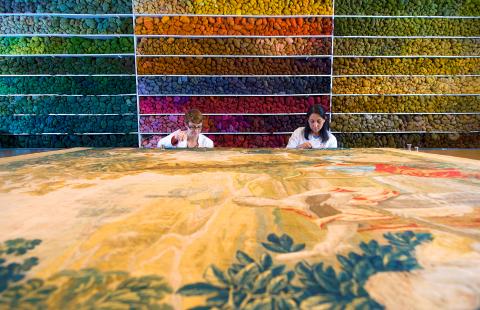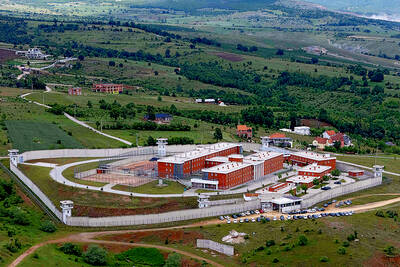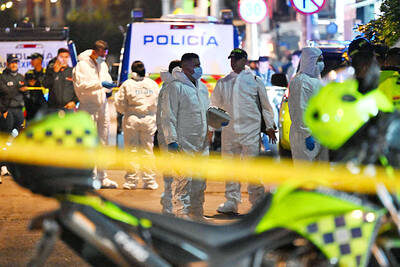The painstaking job of restoring some of the world’s finest ancient tapestries, stitch by stitch, is not for the highly strung or restless.
Returning to its former glory the kind of creation that adorns a cathedral wall or is displayed at a world-renowned museum can take more than a year for tapestry restorers at Royal Manufacturers De Wit.
Tucked away in an elegant medieval monks’ residence in Belgium, head restorer Veerle De Wachter and her white-coated, all-female team of 15 labor away with needle and thread, adding thousands of stitches to a single piece.

Photo: AFP
“Someone who is nervous or excitable would never manage it,” she told reporters, seated in front of a vast wall stacked with bundles of thread, a colorful reminder of the days when the company produced its own tapestries.
The work calls for a demanding degree of focus, knowledge of fabrics and thoroughness, she said.
“You need a calm person, who can work in a concentrated manner without being distracted with what’s going on around them,” she said.
As well as the traditional meticulous craftsmanship, resuscitating the faded scenes and preparing them for the future ravages of time requires modern technology.
Museums such as the Louvre in Paris, the Metropolitan Museum of Art in New York and the Hermitage in Saint Petersburg in Russia, entrust the restorers with their finest pieces in cotton and silk, some with strands of silver and gold.
Based in the northern Flemish town of Mechelen, the Royal Manufacturers De Wit was founded 1889 and is the biggest restorer of tapestries in the world, based on the value of the pieces it restores.
These have included legendary works such as The Lady and the Unicorn, a series of six tapestries woven in wool and silk in Flanders in the Middle Ages, on display at the Cluny museum in Paris.
There is also a collection of 29 enormous tapestries from Saint John’s Co-Cathedral in Malta which the restorers have been gradually working through in the past dozen years in a project estimated to cost US$1 million.
Difficult to transport due to their enormity, the 17th century Flemish tapestries have been sent to Royal Manufacturers De Wit in pairs.
First cleaned of dust, the artworks are then washed with an enormous spraying machine. Only once they are dried do the restorers set about their work.
Restoration overtook tapestry making as the mainstay of the business about 40 years ago.
“At the end of the 1970s weaving workshops had a very hard time because tapestries were too expensive and no longer in fashion,” said Yvan Maes De Wit, great-grandson of the firm’s founder, accounting for the shift toward restoring and conserving historic tapestries.
The company came up with new cleaning techniques, using a combination of suction and spraying to protect the fibers against strain. Washing dyed cloth is a very risky step in the restoration process, as cotton often frays and silk disintegrates over time and in light.
The restorers have also had to develop expertise in removing huge tapestries from their hanging places, a delicate task given their size, weight and fragility.
De Wit recalls the stress of a “very dangerous operation,” to remove a 9m by 14m tapestry suspended 25m high in the entry hall of the UN Headquarters in New York, using “gigantic scaffolding.”
Meanwhile, his team of restorers, silently hunched over their work, seated on benches in a vast white room, is known, above all, for having an “eye for color.”
The company also makes its own silk and cotton threads to match the original historic colors as closely as possible.

By 2027, Denmark would relocate its foreign convicts to a prison in Kosovo under a 200-million-euro (US$228.6 million) agreement that has raised concerns among non-governmental organizations (NGOs) and residents, but which could serve as a model for the rest of the EU. The agreement, reached in 2022 and ratified by Kosovar lawmakers last year, provides for the reception of up to 300 foreign prisoners sentenced in Denmark. They must not have been convicted of terrorism or war crimes, or have a mental condition or terminal disease. Once their sentence is completed in Kosovan, they would be deported to their home country. In

Brazil, the world’s largest Roman Catholic country, saw its Catholic population decline further in 2022, while evangelical Christians and those with no religion continued to rise, census data released on Friday by the Brazilian Institute of Geography and Statistics (IBGE) showed. The census indicated that Brazil had 100.2 million Roman Catholics in 2022, accounting for 56.7 percent of the population, down from 65.1 percent or 105.4 million recorded in the 2010 census. Meanwhile, the share of evangelical Christians rose to 26.9 percent last year, up from 21.6 percent in 2010, adding 12 million followers to reach 47.4 million — the highest figure

LOST CONTACT: The mission carried payloads from Japan, the US and Taiwan’s National Central University, including a deep space radiation probe, ispace said Japanese company ispace said its uncrewed moon lander likely crashed onto the moon’s surface during its lunar touchdown attempt yesterday, marking another failure two years after its unsuccessful inaugural mission. Tokyo-based ispace had hoped to join US firms Intuitive Machines and Firefly Aerospace as companies that have accomplished commercial landings amid a global race for the moon, which includes state-run missions from China and India. A successful mission would have made ispace the first company outside the US to achieve a moon landing. Resilience, ispace’s second lunar lander, could not decelerate fast enough as it approached the moon, and the company has

‘THE RED LINE’: Colombian President Gustavo Petro promised a thorough probe into the attack on the senator, who had announced his presidential bid in March Colombian Senator Miguel Uribe Turbay, a possible candidate in the country’s presidential election next year, was shot and wounded at a campaign rally in Bogota on Saturday, authorities said. His conservative Democratic Center party released a statement calling it “an unacceptable act of violence.” The attack took place in a park in the Fontibon neighborhood when armed assailants shot him from behind, said the right-wing Democratic Center, which was the party of former Colombian president Alvaro Uribe. The men are not related. Images circulating on social media showed Uribe Turbay, 39, covered in blood being held by several people. The Santa Fe Foundation